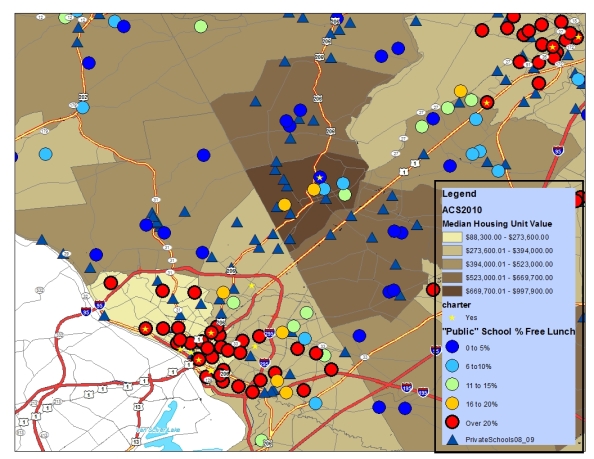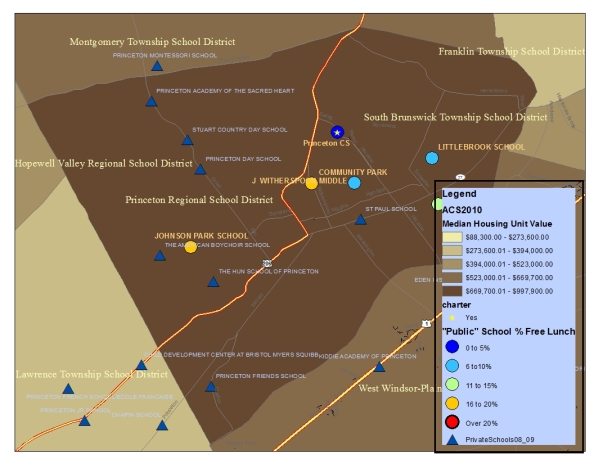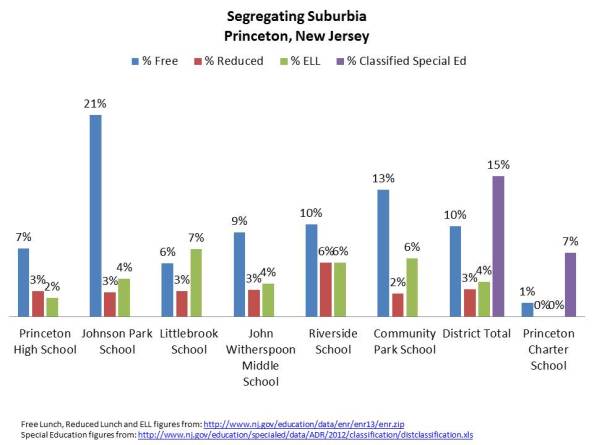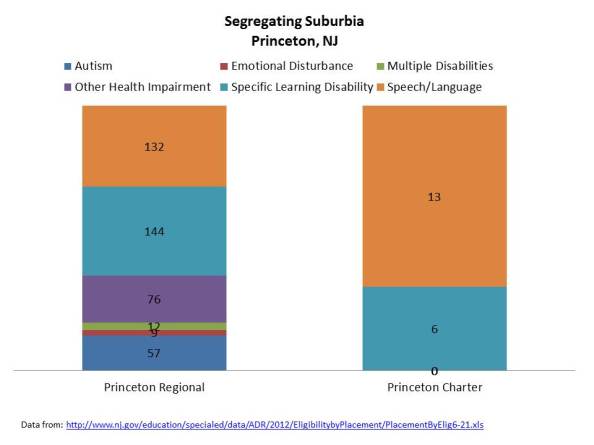This from School Finance 101:
Others around me have for some time been raising concerns about the emergence of boutique, suburban charter schools. Until now, I’ve largely blown off those concerns in part as I’ve questioned just how much sorting a charter school can achieve in a relatively homogeneous suburban area.
Suburbs have their own unique portfolio of schools. One might find in any leafy suburb near a major metropolitan area a very fine local public school district, perhaps a private catholic school in certain regions of the country and in many areas, an elite private independent day school or two – oft named “day school” or “country day school.” These portfolios have been in existence, in some cases, for centuries. At some future point, I may discuss more extensively the public private balance issue and the role that elite, and less so, private schools play when embedded in otherwise elite communities that also have relatively elite public school systems.
Rarely would one expect to find the charter school movement trying to infiltrate this environment, adding that other element to the portfolio. And if and when this does happen, what niche do they try to fill? On the one hand, one might try to establish a charter that handles the “difficult” cases from the local school system – those that might not fit particularly well in either the public system or have access to appropriate private schooling.
But, I’m reminded… though I can’t find the link right now… of a Palo Alto, CA charter school that had basically established itself as the equivalent of a publicly subsidized elite private school. [Found! By a commenter below] It’s a rather clever financial model. If elite private school tuition is running at about $30k per year per child…and per pupil cost of a quality private education program about $32 to $35k… one could either pay that price, or gather a group of close friends, and apply for a charter, where each child might receive an allotment of $10 to $15k from the local district and then parents could quietly agree to chip in the other $15k to achieve similar quality schooling to the private option – at half the price.
Of course, there are many additional costs of getting that ball rolling, including finding and leasing space for start up years, and running capital fundraising campaigns for future years. By establishing a charter school in this way, these parents really couldn’t officially exclude others from their school or obligate private contributions within their “club”… but they sure could make any free-rider, or other resource drain on their schooling model feel uncomfortable enough to leave.
On the one hand, it might not be considered that problematic for a group of parents with “average children” in the local district to require (via establishing a charter school) that district to subsidize their quasi-private endeavor. I would argue that it becomes more problematic when an above average income group in the community, with relatively low need children (by usual classifications), obligates the local public school district to subsidize their segregationist preferences. That is, asking those less well off than you to subsidize your quasi-private school alternative.
But, just how much sorting can a suburban charter school achieve anyway? And can a suburban charter school establish itself as a quasi-elite-private school in a market where there are already several private schooling options. That is, would parents of advantaged children actually seek to establish a school that taxes those less well off than them, to subsidize their charter school, instead of paying the full price of tuition at local private schools? Evidence from Princeton, New Jersey suggests that the answer to this question may in fact be yes!
Let’s take a look.
Here’s the lay of the land… from the broad viewpoint… with district housing values in the brown shading.
Princeton is the dark area in the middle of the picture, with very high average housing values. Princeton also is home to numerous… and I mean numerous private independent day and boarding schools, many of which (along a single road) serve a large portion of school aged children from Princeton and surrounding communities and many of which have been around for a very long time.
Princeton is also known for having and exceptionally strong local public district. To the south and west is Trenton, with high poverty schools including high poverty charter schools (yellow stars). Notably, in Princeton the lowest poverty “public” school is Princeton Charter School. Princeton Public Schools each have much higher rates of children qualified for free or reduced priced lunch.
Here’s a zoom in on Princeton:
While many of the triangles (private schools) in other parts of the state are preschools, etc., many in Princeton are actually relatively large elite private day and boarding schools. Rather amazingly, Princeton Charter School appears – at least by exclusion of low income children – to be positioning itself as a publicly subsidized alternative to the elite private schools and not as a more broadly accessible charter alternative.
Here’s a breakout of the details on the Princeton Charter population compared to the district:
And here’s the composition of the special education populations:
That is, PCS has only the mildest, lowest cost children with disabilities.
Put bluntly, these figures show that the parent population of Princeton Charter is obligating the parents of much less advantaged children, including parents of children with special education needs, subsidize their preference to have a school more like the private day schools along Great Road.
While I’m still not entirely sure what to make of this… it does concern me.
It also ought to raise questions for leaders of private school alternatives in these communities. On balance, I’ve never seen the charter school movement as a particular competitive threat to private independent day schools, as charters have often been primarily urban, serving minority populations and employing “no excuses” strategies that most parents in leafy suburbs would not find palatable for their own children.
Urban charter schools have arguably taken their toll on urban catholic school enrollments, but that’s another story. But, to the extent that state charter policies permit the type of school establishment and segregation going on in Princeton, more an more parents may find ways to organize quasi-private-elite schools to serve their needs – effectively seeking taxpayer charity to support their country club preferences. This indeed may pose a threat to financially less well endowed private schools.
In a twisted sort of way, it’s rather like asking your local public parks department to pay for your membership to the local private country club – thus reducing the quality of services to others who really don’t have access to the country club (even if it proclaims it’s open to all comers).
Much more to ponder here… but the numbers on Princeton Charter School certainly raise some serious red flags.
Note: In New Jersey and elsewhere, there are numerous other taxpayer subsidies that support private schooling, ranging from property tax exemptions and exemptions on charitable gifts, to textbook subsidies (loans from local districts) and transportation reimbursements. So, to an extent, all private schools and privately schooled children are receiving some level of subsidy at taxpayer expense. But, that level increases dramatically if/when the local public district is also required to hand over the full annual operating expense per child.




No comments:
Post a Comment